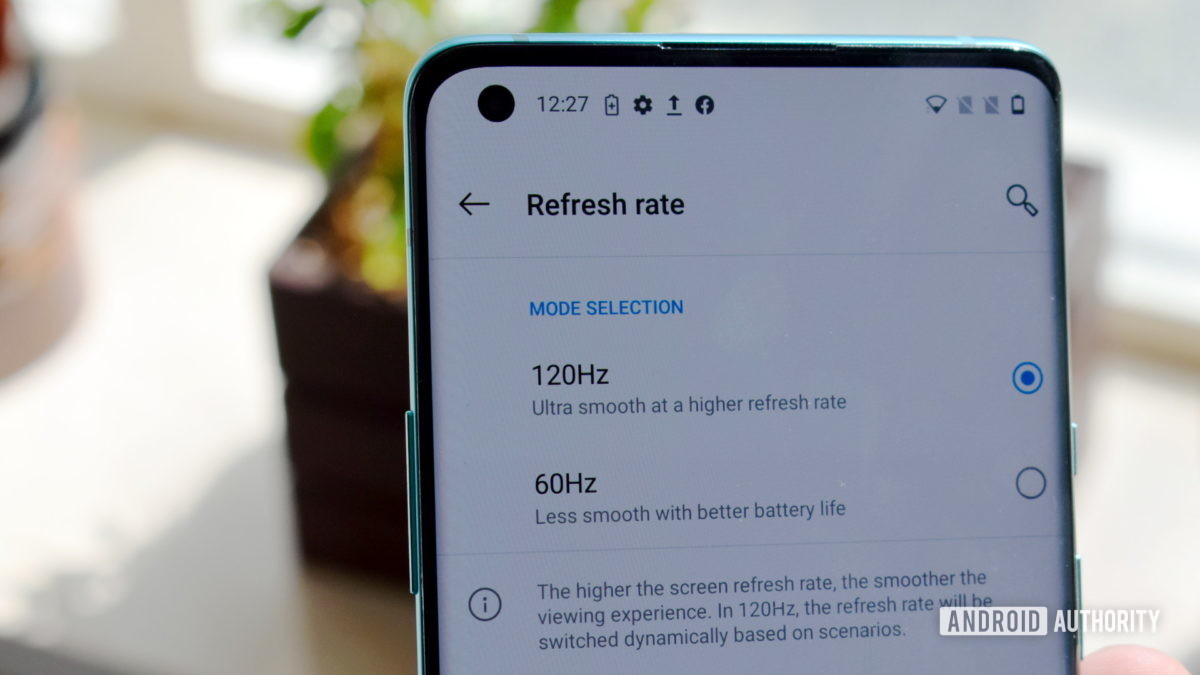90Hz and 120Hz panels are the latest trend in the smartphone world but don’t be fooled by the marketing taglines. Not every 120Hz phone offers the same display quality, features, and certainly not the same battery life.
90Hz and 120Hz panels are the latest trend in the smartphone world but don’t be fooled by the marketing taglines. Not every 120Hz phone offers the same display quality, features, and certainly not the same battery life. There’s a lot that goes into a great display besides just the frame rate on the spec sheet.
For starters, we’ve already seen phones sporting high refresh displays disable these modes out of the box or hamper their implementation for the sake of battery life. I’m looking at you Google and Samsung. There are also questions to answer about the quality of 120Hz displays that are quickly making their way to the mid-range tier. Are they really comparable to those offered by flagship handsets?
We’ve covered some of what goes into the ins and outs of a great modern smartphone display in the article below delving into the OnePlus 8 Pro‘s industry-leading display. However, there’s much more to the story and a lot of hype to kill and myths to debunk surrounding the 120Hz display trend.
120Hz isn’t a quality guarantee
While 90Hz and 120Hz displays make the motion from certain apps and elements of the user interface (UI) appear smoother, a high refresh rate is not itself a sign of display quality. Color accuracy, gamma correction, and white balance are all independent of the refresh rate and have a much larger impact on the look of most content. While 120Hz may look smoother, pictures and videos can still look over- or under-saturated on a poorly calibrated display.
With this in mind, individual display models from different manufacturers all look quite different, even though they may have the same refresh rate. For example, cheaper displays are more likely to have noticeable issues and poor color calibration. Be cautious of affordable phones boasting high refresh rate panels as they could be attempting to distract from other issues. On the flip side, flagship tier phone displays can go above and beyond the factory color calibration, as OnePlus showcased with the 8 Pro. This is why it’s still worth paying attention to traditional display quality metrics and not just the refresh rate.
A flagship 60Hz display can look better than a cheap 120Hz panel.
Traditional 60Hz displays can still look better than 120Hz panels, at least in terms of color accuracy. This is especially true when comparing flagship-tier 60Hz panels to cheaper 120Hz displays. Overall quality is definitely more important than a slightly more fluid feeling user interface. Furthermore, just because a display boasts 90 or 120Hz capabilities doesn’t mean that the majority of the apps and content actually make the most of it.
Apps, content, and Android matter

It’s not just display quality that varies from device to device — the availability of high refresh rate content can vary too. There’s little point owning a phone with a 120Hz display if it’s never used after all, so this is essential to dig into.
The frame rate of an app or game depends not just on the underlying hardware, but also the way that the application is coded to render and the way Android works. Google has published insights into how high refresh rate displays work with content on Android. The first point worth noting is that frame rates are limited by rendering times, controlled by the Android Choreographer. 120Hz displays have just 8.3ms in-between frames in which the GPU has to draw the frame. Some apps and games render at the display’s v-sync refresh rate, so they can operate at the full frame rate. However, others simply take too long to render or have custom rendering pipelines with slower update speeds, so they simply can’t hit 120Hz. Instead, games may stick to 90, 60, 45, or even 30fps.
Android 11 improves handling of mixed refresh rate content, providing apps make use of the new API.
The key takeaway here is that just because a phone has a 120Hz display that doesn’t actually mean all apps run at 120Hz. Phones with more processing power are more likely to hit high frame rate targets with lower latency, although some apps may even be optimized for specific platforms.
The situation is further complicated by using multiple apps and UI elements at once. Google notes that 120Hz displays are good for viewing 24, 30, 45, and 60fps content without judder, as these rates as easily divisible by 120. Playing back a 24fps video on a 120Hz display avoids the 3:2 pulldown algorithm required by a 60Hz display, for example. However, conflicts can occur between software, such as a low frame rate video and high frame rate UI. At which point Android has to step in and pick a frame rate, which can result in judder and/or a fallback to the standard 60Hz.
There’s a new setFrameRate API in Android 11 that helps to find the optimal frame rate for multiple apps running at once. However, current devices have to make do with a preference setting that can lead to conflicts. Ultimately, applications and games can influence the refresh rate but the final decision is made by the platform. Expect next year’s Android 11 phones to handle mixed refresh rate content better than current models.
Overall, hitting very high frame rates for every app is highly unlikely. Instead, Android dynamically switches frames rates to best match the app you’re currently using. But even this may depend on the manufacturer’s implementation.
Display processors are a differentiator

If that wasn’t convoluted enough, devices can also add in their own display processing layer to upscale or remove judder outside of the standard Android framework. Processing power is important here, as some effects can be energy-intensive. Dedicated display processors (DPU) can run these tasks more efficiently. That’s right, yet another processor inside your smartphone!
Qualcomm’s Snapdragon processors include display and visual processors as part of its Adreno GPU pipeline. These handle video decoding as well as graphics rendering, and the application processor can also run additional display processing software. For example, Pixelworks, a company specializing in display enhancement technology, leverages the Snapdragon 865 to run its Soft Iris calibration and features like tone-mapping and SDR to HDR on the OnePlus 8 series. Other SoCs have their own display processing units as well, but mid-range and lower-end chips don’t have the hardware to run higher-end features efficiently. For example, the Snapdragon 765G only supports 120Hz up to FHD+, while the 865 can manage 144Hz at QHD+ resolutions.
Display processors power higher-end features with improved power efficiency.
Complex display features run more efficiently on dedicated processors. These include Pixelworks’ Iris5 and Arm’s Mali-D77 or D71, although these offer different capabilities. The Iris 5, for example, is capable of MEMC video frame rate upscaling and judder removal. Upscaling and interpolating video, games, and other apps can help improve smoothness even if the app runs at lower frame rates natively. Advanced display processors not only bring new features but can improve energy consumption too, a very important consideration with power-hungry 120Hz displays.
Extra features and processing options can help elevate a standard high refresh rate display to a more consistent, smooth experience. The inclusion of high-end display processors can also help with power consumption, allowing you to keep the 120Hz mode on all the time. It’s a hidden difference, but an important one.
Not all 120Hz displays are equal

High frame rate displays are certainly nice to have, but there’s much more to overall display quality than just the hertz. Standard display quality metrics still apply and a 90 or 120Hz label doesn’t automatically mean great colors or gamma. That said, 120Hz panels can certainly look excellent, especially if the phone has the software and processing power for enhanced calibration and tone mapping features.
It’s also worth researching what, if any, high refresh rate and other display features ship with a device. A dedicated processor powering enhanced features can be the difference between smoother content and all-day battery life, and a sub-par 120Hz experience. Not forgetting that newer apps and Android 11 will help increase the range of scenarios where high refresh rates are enabled.
And that’s why not all 120Hz smartphones are the same.



Comments